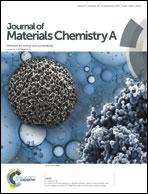Facile self-templating large scale preparation of biomass-derived 3D hierarchical porous carbon for advanced supercapacitors†
Abstract
Corn husk, a renewable biomass, has been successfully explored as a low-cost crude carbon source to prepare advanced higher-value 3D HPCs by means of KOH pre-treatment and direct pyrolysis, the synthesis route is simple, self-templating and easy to scale-up for industrialization. The CHHPCs present many advantages for supercapacitor applications, including higher surface area (928 m2 g−1), hierarchical porosity consisting of macro, meso, and micropores, a turbostratic carbon structure, uniform pore size, 3D architecture and rich O-doping (17.1 wt%). The supercapacitor performance of CHHPCs was evaluated in a 6 M KOH electrolyte and 1 M Na2SO4 electrolyte. The CHHPCs exhibit a high specific capacitance of 356 F g−1 and 300 F g−1 at 1 A g−1, 20 A g−1, respectively, ultra-high rate capability with 88% retention rate from 1 to 10 A g−1 and outstanding cycling stability with 95% capacitance retention after 2500 cycles. The CHHPCs symmetric supercapacitor display a high energy density of 21 W h kg−1 at a power density of 875 W kg−1 and retains as high as 11 W h kg−1 at 5600 W kg−1 in 1 M Na2SO4 electrolyte. The facile, efficient and template-free synthesis strategy for novel 3D-HPCs from biomass sources may promote commercial application of 3D-HPCs in the fields of supercapacitors, lithium ion batteries, fuel cells and sorbents.


 Please wait while we load your content...
Please wait while we load your content...